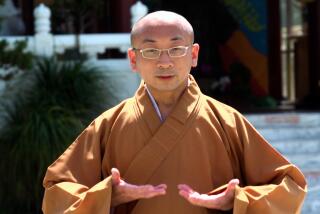China’s Shaolin Temple: Kung Fu Mecca
- Share via
SHAOLIN TEMPLE, China — For 1,500 years, monks at Shaolin Temple have been trained to pray without the blink of an eye and kill with a flash of the hand.
They are the masters of Shaolin kung fu, a combination of shadow boxing, swordplay and body control techniques that in recent years has gained a wide following in China and other parts of Asia.
Today their monastery in the foothills of the sacred Mt. Songshan in central China’s Henan province has become a small mecca for those seeking the secret to bodies that can fly and whirl in perfect self-defense.
It also draws some 2 million tourists a year, up from 200 a decade ago, many of them fans of martial-arts movies out of China and Hong Kong that depict the past exploits of Shaolin monks.
“The Way of Power Has No End,” says one inscription on the temple walls, one of the few signs to the casual visitor that the monks of this temple take a different road to nirvana, the Buddhist state of perfect blessedness, peace and bliss.
The temple’s 100 monks, ranging in age from 18 to the 80s, shuffle among the pine trees or nap in the sun, bundled up in heavy overcoats and wool skullcaps to keep out the winter cold.
But when asked for a show of Shaolin kung fu, a shy young monk springs into a blur of action, his big stick whistling through the air as he lunges, twists and twirls.
In past centuries the monks used their skills as warriors to defend the faith, but now they view it mainly as a form of self-discipline.
“The practice makes my body stronger so I can meditate longer,” said the monk, 24-year-old Shi Yanqin.
Shi said he rises at 4:30 every morning to pray, read Buddhist scriptures and practice. At 7 o’clock, he has a breakfast of mantou , or steamed bread, and spends the day in meditation and manual labor.
The monk said he sits in prayer without moving for about five hours a day, and he can leave the temple grounds only with permission. He receives an allowance of 20 yuan (about $5.40) a month.
Shi said he came to Shaolin four years ago primarily because he believes in Buddhism and wants to devote his life to its teachings. But such is not the case for all who seek to become Shaolin acolytes.
“There are still many young men who come just to learn kung fu,” said the head abbot, De Chan, 82. “Unless they have a special introduction, we turn them away.”
Until a few years ago the white-bearded abbot, now frail and bedridden, led his disciples in their daily kung fu training. He first entered Shaolin at age 7, he said.
He added that the temple now has a separate school for young people in pursuit of kung fu skills without the religion. Its 400 students study kung fu techniques and theories for as long as three years.
The Shaolin Temple was ordered built in 495 by Emperor Xiaowen of the Northern Wei Dynasty and is the oldest Zen Buddhist temple in China. Its links with the martial arts go back to the Indian monk Damo, or Bodhidharma, who arrived in 527.
Damo is said to have achieved enlightenment by sitting in a cave of Mt. Songshan for nine years. To keep his body strong, he exercised by imitating the movements of a bird flying or an animal leaping, creating the basic moves of Shaolin kung fu.
The temple flourished after 13 of its strong-armed monks rescued a Tang Dynasty emperor in distress during the 7th Century. At its peak there were more than 2,000 monks at Shaolin.
In 1928, a local warlord burned down much of the temple in a fire said to have lasted 45 days. After the Communists came to power in 1949, the temple lost its land, and its monks were forced to find jobs.
More to Read
Sign up for Essential California
The most important California stories and recommendations in your inbox every morning.
You may occasionally receive promotional content from the Los Angeles Times.













